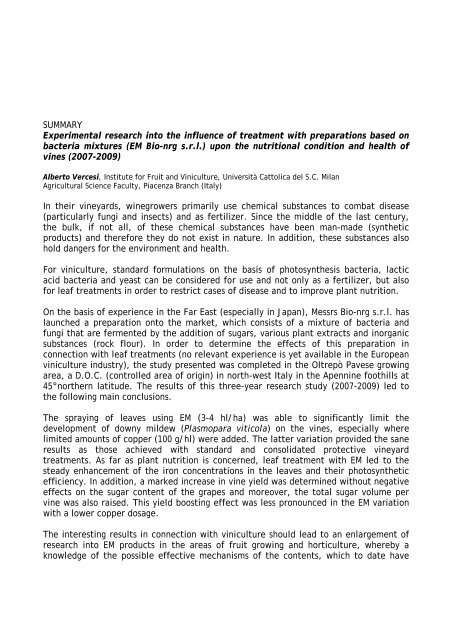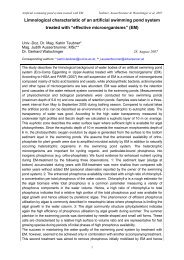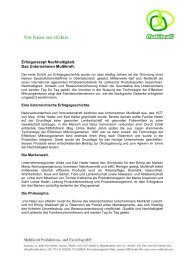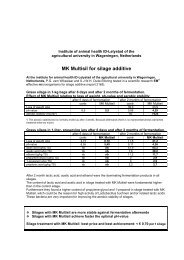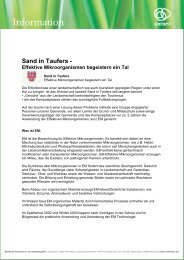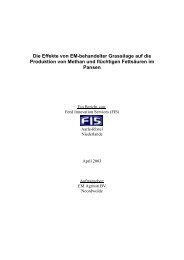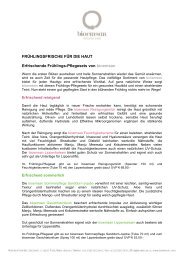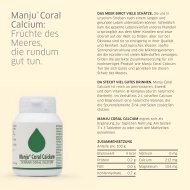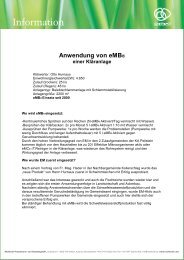(EM Bio-nrg srl) u - Multikraft
(EM Bio-nrg srl) u - Multikraft
(EM Bio-nrg srl) u - Multikraft
You also want an ePaper? Increase the reach of your titles
YUMPU automatically turns print PDFs into web optimized ePapers that Google loves.
SUMMARY<br />
Experimental research into the influence of treatment with preparations based on<br />
bacteria mixtures (<strong>EM</strong> <strong>Bio</strong>-<strong>nrg</strong> s.r.l.) upon the nutritional condition and health of<br />
vines (2007-2009)<br />
Alberto Vercesi, Institute for Fruit and Viniculture, Università Cattolica del S.C. Milan<br />
Agricultural Science Faculty, Piacenza Branch (Italy)<br />
In their vineyards, winegrowers primarily use chemical substances to combat disease<br />
(particularly fungi and insects) and as fertilizer. Since the middle of the last century,<br />
the bulk, if not all, of these chemical substances have been man-made (synthetic<br />
products) and therefore they do not exist in nature. In addition, these substances also<br />
hold dangers for the environment and health.<br />
For viniculture, standard formulations on the basis of photosynthesis bacteria, lactic<br />
acid bacteria and yeast can be considered for use and not only as a fertilizer, but also<br />
for leaf treatments in order to restrict cases of disease and to improve plant nutrition.<br />
On the basis of experience in the Far East (especially in Japan), Messrs <strong>Bio</strong>-<strong>nrg</strong> s.r.l. has<br />
launched a preparation onto the market, which consists of a mixture of bacteria and<br />
fungi that are fermented by the addition of sugars, various plant extracts and inorganic<br />
substances (rock flour). In order to determine the effects of this preparation in<br />
connection with leaf treatments (no relevant experience is yet available in the European<br />
viniculture industry), the study presented was completed in the Oltrepò Pavese growing<br />
area, a D.O.C. (controlled area of origin) in north-west Italy in the Apennine foothills at<br />
45°northern latitude. The results of this three-year research study (2007-2009) led to<br />
the following main conclusions.<br />
The spraying of leaves using <strong>EM</strong> (3-4 hl/ha) was able to significantly limit the<br />
development of downy mildew (Plasmopara viticola) on the vines, especially where<br />
limited amounts of copper (100 g/hl) were added. The latter variation provided the sane<br />
results as those achieved with standard and consolidated protective vineyard<br />
treatments. As far as plant nutrition is concerned, leaf treatment with <strong>EM</strong> led to the<br />
steady enhancement of the iron concentrations in the leaves and their photosynthetic<br />
efficiency. In addition, a marked increase in vine yield was determined without negative<br />
effects on the sugar content of the grapes and moreover, the total sugar volume per<br />
vine was also raised. This yield boosting effect was less pronounced in the <strong>EM</strong> variation<br />
with a lower copper dosage.<br />
The interesting results in connection with viniculture should lead to an enlargement of<br />
research into <strong>EM</strong> products in the areas of fruit growing and horticulture, whereby a<br />
knowledge of the possible effective mechanisms of the contents, which to date have
only been outlined, could be deepened, e.g. the bacterial effect (especially of lactic<br />
acid bacteria) during the creation of an “environment” on the leaf surface, which limits<br />
the spread of downy mildew (Plasmopara viticola), as well as the possible consequences<br />
of the fermentation of herbs and the minerals used, with regard to the availability and<br />
iron nutrition of the leaves. It is highly likely that this was largely, if not exclusively,<br />
responsible for the improvement in photosynthesis efficiency.<br />
danno %<br />
danno %<br />
30<br />
25<br />
20<br />
15<br />
10<br />
5<br />
0<br />
30<br />
25<br />
20<br />
15<br />
10<br />
Peronospora 2007 grappoli postallegagione<br />
5<br />
0<br />
b a<br />
<strong>EM</strong> AZ test<br />
Peronospora 2007 grappoli postinvaiatura<br />
a<br />
a<br />
c<br />
b<br />
<strong>EM</strong> AZ test<br />
100<br />
90<br />
80<br />
70<br />
60<br />
50<br />
40<br />
30<br />
20<br />
10<br />
0<br />
100<br />
90<br />
80<br />
70<br />
60<br />
50<br />
40<br />
30<br />
20<br />
10<br />
0<br />
diffusione %<br />
diffusione %<br />
danno %<br />
danno %<br />
30<br />
25<br />
20<br />
15<br />
10<br />
5<br />
0<br />
30<br />
25<br />
20<br />
15<br />
10<br />
5<br />
0<br />
b<br />
Peronospora 2008 grappoli postallegagione<br />
<strong>EM</strong> <strong>EM</strong> Cu AZ test<br />
b<br />
a<br />
Peronospora 2008 grappoli postinvaiatura<br />
<strong>EM</strong> <strong>EM</strong> Cu AZ test<br />
a<br />
a a<br />
c<br />
c<br />
100<br />
90<br />
80<br />
70<br />
60<br />
50<br />
40<br />
30<br />
20<br />
10<br />
0<br />
100<br />
90<br />
80<br />
70<br />
60<br />
50<br />
40<br />
30<br />
20<br />
10<br />
0<br />
diffusione %<br />
diffusione %
2008<br />
Produzione<br />
e zuccheri<br />
6<br />
5,5<br />
5<br />
4,5<br />
4<br />
3,5<br />
3<br />
2,5<br />
2<br />
1<br />
0,9<br />
0,8<br />
0,7<br />
0,6<br />
0,5<br />
0,4<br />
0,3<br />
0,2<br />
0,1<br />
0<br />
b<br />
produzione per ceppo (Kg) nel 2008<br />
<strong>EM</strong> <strong>EM</strong> Cu AZ test<br />
b c<br />
a b<br />
zuccheri per ceppo (Kg) nel 2008<br />
b<br />
<strong>EM</strong> <strong>EM</strong> Cu AZ test<br />
b<br />
c<br />
a<br />
a
41<br />
40<br />
39<br />
38<br />
37<br />
36<br />
35<br />
Funzionalità fogliare (SPAD) 2009, foglie basali<br />
Funzionalità fogliare (SPAD) preinvaiatura "terzo basale del<br />
germoglio)" nel 2009<br />
c<br />
b<br />
<strong>EM</strong> <strong>EM</strong><br />
fosKMg<br />
c c<br />
<strong>EM</strong> Cu Cu test<br />
a


